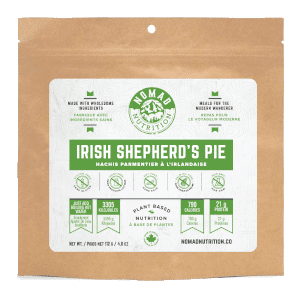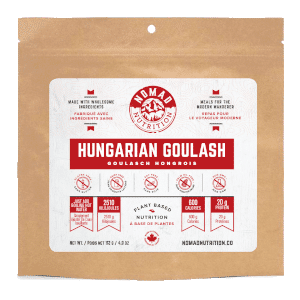I’m always on the lookout for new backpacking food. It’s not that I don’t love some classic Mountain House, but variety is the spice of life, right? And since successful backpacking relies on good nutrition, I’m also always on the lookout for new meals that don’t just taste better but are better for you.
It looks like I’ve found that in Nomad Nutrition’s backpacking meals. They taste great, have a solid nutritional profile, and are made from whole foods, plant-based ingredients—an ethic that I think many of us are trying to work towards. I just tried them out, and so far I love them.
Disclaimer: I am not sponsored by Nomad Nutrition and did not receive products from them for this review. Everything in this post is my honest opinion.
Nomad Nutrition Overview
Nomad Nutrition is a company out of Burnaby, British Columbia with a focus on making healthy, plant-based backpacking food. Their motto is “food without compromise”, which really rings true when you start to read the ingredients list.
Every ingredient on the list for every one of their meals is not only something I can pronounce, but real food that I recognize. Things like carrots, lentils, onions, garlic, and olive oil, that are real food and highly nutritious. This is something that you rarely find in food that’s supposed to pack small and have a long shelf-life.
All the meals are also vegan, gluten-free, and use non-GMO ingredients as much as possible. These are some of the most wholesome meals on the market.
REVDry
Another unique thing about Nomad Nutrition is that they use REVdry, a patented drying process that is different from freeze-drying or dehydrating.
Freeze-drying is what the majority of backpacking food companies use today. It removes more moisture than dehydrating, increasing shelf-life and reducing weight. It also preserves more of the nutritional profile. The main downside is that freeze-dried foods tend to take up more space in your pack. The process also involves several steps and takes a lot longer, increasing energy costs.
Dehydrating is the old-school method, which is simpler but results in a heavier, less shelf-stable product with fewer nutrients.
REVdry is like a combination of the two. It uses a vacuum to remove air from the drying process, allowing it to be done at a much lower temperature than typical dehydrating. The result is near-perfect nutrient and flavor retention, and food that still looks like, well, food, when you rehydrate it. It’s also 6 times faster than freeze-drying, so it’s good for the planet as well. Given how great the end result is, I’m all for it.
One thing to note about REVdry, though: because they include large chunks of whole food, and because it ends up a little more similar to dehydrated food than freeze-dried food, it takes longer to rehydrate than I’ve gotten accustomed to. That’s only a minor drawback, but plan on waiting about twice as long as freeze-dried before eating it.
Nutrition Info
Since the company is called Nomad Nutrition, I think it’s important to go over how these meals stack up nutritionally. There a ton of great meal companies out there, but for the purposes of this review, I’m going to compare them to my old standby: Mountain House.
Caloric Density
One thing I was initially surprised by is just how calorie-dense these meals are. Nearly all of their options have more than 600 calories (per 100-112g, or 2 servings), and two of them have almost 800. Mountain House, by comparison, has 600 calories or less for every single one of their meals (with most being between 400-500). The ones that do get close to 600 calories are usually 120 grams or higher per pouch, so the caloric density on average is really no comparison to Nomad’s.
Macronutrients
You might assume right off the bat, as I did, that they probably achieve high caloric densities by stuffing their meals with fats. While their meals do tend to have about double the fat that Mountain House meals have, they also have roughly double the protein and only about 25-50% more carbohydrates.
This all means that their meals have a lot more calories while still maintaining near-optimal macronutrient ratios—between 2:1 and 3:1 carbs to protein, and around 20-30% total fat. What that means for you on the trail is that you’ll have more sustained energy, and your muscles will be able to recover much better than if you were eating Mountain House. As far as macronutrients go, these meals are near-perfect for recovering after a hard day of backpacking.
Another big bonus is that their meals are very high in fiber (between 30%-50% of the carbs are fiber). Mountain House usually has almost none. This (at least partially) prevents the, um, digestion issues that so many of us are familiar with on the trail. I’m all for that.
Other Nutrients
One of the big claims that Nomad makes is that their REVdry process retains a lot more Vitamin C than others. Most of their meals have 40% or more of the recommended daily value of Vitamin C (some are over 100%), whereas Mountain House doesn’t even list it. This isn’t something that’s super important to me (as my backpacking trips are usually too short to make a huge difference), but it’s a nice bonus.
They also sport high levels of iron, which is often lacking in backpacking food. Iron deficiency can make you feel fatigued, so it really does matter for physical performance.
Vitamin A is high in most of their meals as well, which is essential for muscle growth and recovery. Low levels can make you feel fatigued and weak, especially when combined with prolonged physical exercise over multiple days. This is a huge plus for backpackers.
Taste Test
Alright, so the nutrient profile is phenomenal. But if it doesn’t taste good, you’re still not going to eat it. Fortunately, they nailed it here too. I have yet to try all of their options, but the two that I have tried were awesome (and I don’t eat vegan to begin with). You have to keep a little bit of an open mind because their meals don’t exactly fit within traditional standards, but if you take them at face value they really are great.
Irish Shepherds Pie

Calories: 790 (per 1 pouch/ per 100 grams)
- Carbs: 58g (26g fiber)
- Fat: 21 g
- Protein: 21 g
- Vitamin A: 150% DV
- Vitamin C: 45% DV
- Iron: 85% DV
I grew up eating traditional shepherd’s pie, so at first, this one threw me off. It’s not the sour cream-y, mashed potato-y calorie bomb that mom’s shepherd’s pie was (which I will always prefer), but for what it is it’s delicious. It’s not thick and saucy, but unlike many freeze-dried meals, you can actually pick out individual chunks of carrot, potato, and onion. And despite not being loaded with cheese and sour cream, they did a good job with their spice blend to make it super flavorful.
Hungarian Goulash

Calories: 600 (per 1 pouch/ per 100g)
- Carbs: 58g (21g fiber)
- Fat: 22 g
- Protein: 20 g
- Vitamin A: 90% DV
- Vitamin C: 120% DV
- Iron: 50% DV
Again, I grew up eating a version of goulash that always included ground beef, so my tastebuds had certain expectations. I also expected elbow macaroni, which in my mind is always a part of goulash, but that was also missing (a quick search of “Hungarian style goulash” told me I should have already known that would be the case, but I digress). What I got instead was a flavor-packed and ultra-satisfying blend of potatoes, carrots, onions, kidney beans, and a bunch of other veggies. It has a little bit of heat to it too, with smoked paprika and adobo chili pepper, which I’m always a fan of. Just like the shepherd’s pie, this one requires you to suspend your expectations a little, but once you do you’ll find that it’s awesome.
One Drawback: Price
The only issue I can find with these meals, is, unfortunately, the price. For a full-size, 2 serving Nomad meal, you can expect to pay $16 CAD, or about $13 USD. That’s on the high end for backpacking meals for sure, but before you discard them, think about it in terms of calories.
I said above that comparable Mountain House meals are significantly less calorie-dense. On average Nomad Meals have between 30% and 50% more calories per ounce than Mountain House. And when you compare the prices, those numbers are almost exactly the same— Nomad meals cost about 30% to 50% more than Mountain House meals (depending on which meals you choose to compare). So per calorie, the cost is roughly the same. The difference is that Nomad meals are a hell of a lot better for you.
I know the price will still be prohibitive for a lot of people, but if you can even work in a couple of these meals every now and then, you’ll be better off for it.
Conclusion
Overall, I’m a big fan of Nomad Nutrition’s meals. The caveat is that they won’t be similar to the freeze-dried meals you’re used to—they’ll take longer to cook and won’t quite have that comfort food feel of something like Mountain House. But they truly are delicious if you can suspend your expectations, you’ll finish them feeling more satisfied, and you’ll sleep better knowing you’ve given your body everything it needs to keep trekking.
